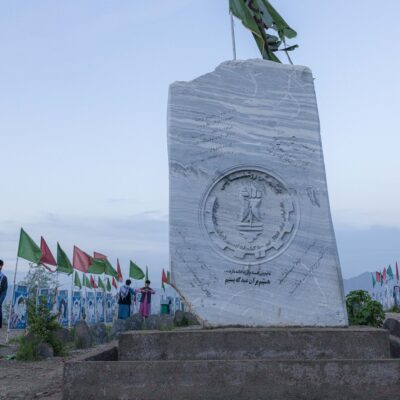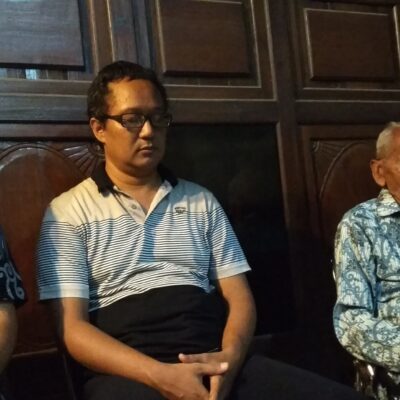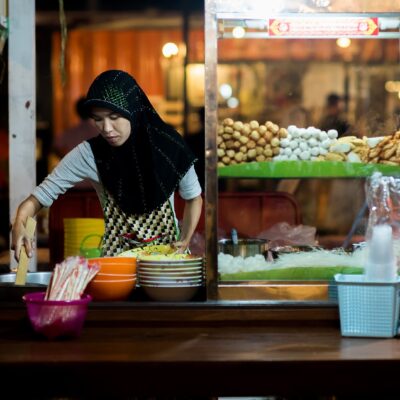Language has a strange place in the intangible cultural heritage (ICH) safeguarding efforts of Chinese governments and UNESCO (United Nations Educational, Scientific and Cultural Organisation). Languages themselves are not recognised on UNESCO’s lists, nor are there specific plans for their safeguarding. However, linguistic expressions of different groups are available for safeguarding, and other traditions are often taught and transmitted in minoritised languages. As such, even though languages are not explicitly safeguarded, they are implicitly part of the broader ‘heritage regime.’ This makes traditions recognised as heritage especially powerful in a moment of heavy pressure on the transmission and use of minoritised languages in the People’s Republic of China.
With particular attention to the Gesar epic (but also touching on other traditions), I examine how intangible cultural heritage recognition has made certain traditional language practices visible in Yushu (Yul shul) Tibetan Autonomous Prefecture, even in the face of a restricted space for Tibetan language expression in the region more generally.
The bards
Lobzang sits on a tall chair at the front of a windowless room filled with benches and deep-backed Tibetan style sofas. He wears a pointed hat and a traditional Tibetan shirt, and sometimes he holds a white silk scarf in his hands (at other times it sits in his lap). The hat is not like anything Tibetans wear on a regular basis: with silk streamers hanging down around his shoulders, and three features that look like eyes, the hat serves as a clear indication that he is a babdrung (བབས་སྒྲུང་།), an inspired bard of the Tibetan “national” epic, called by some the longest epic in the world.
The epic represents a rich distillation of Tibetan folk culture into a single, massive opus. It combines verse, prose, song, speech, and proverbs, drawing on Tibetan folk cosmology that extends well beyond the tangible world. It tells of the King’s incarnation, his difficult childhood, winning a horse race to ascend to the throne, and his victories over neighbouring kingdoms. As a living epic, certain versions even include Gesar’s exploits against the Nazis. To many, Gesar is both a historical figure and a deity who can help with real-world concerns. Transmitted for centuries by bards from across the Tibetan region (and as far as Mongolia and Pakistan), the epic is especially popular in the mountainous regions of Yushu, Golok, and Dege that are widely believed to be the king’s homelands.
For nearly an hour straight, Lobzang recounts the exploits of King Gesar of Ling and his 30 heroes, sometimes speaking in a measured but unrelenting pace and at others breaking into song to recount speeches from different characters. He accentuates moments and voices with gestures: stroking a beard when speaking as an elder or drawing a sword when readying for a fight. After a short break for a drink of water, he goes again for another unbroken 45 minutes. I have rarely heard anybody speak with such unrelenting fluency in any language. Today, he recounts a portion of the popular “horse race” episode, where the boy Joru wins an exciting horse race and ascends to the throne, thus becoming King Gesar. Audiences come and go throughout the performance. Most stay only for a few minutes, but some remain long enough to film a segment that will provide content for their social media pages. A few elderly audience members stay for the entire performance. Next to me, a young boy accompanying his grandfather imitates the bard’s movements.
Bards may perform at children’s birthday parties and at weddings, in the homes of patrons who invite them, or in government sponsored “epic houses” (སྒྲུང་ཁང་།) where fans may go and listen at their leisure. But despite being a masterwork and a lodestone for Tibetan culture, what interests me at present is Lobzang, and the bards like him, who carry the centuries-long unbroken tradition of performance into the present. Their lives, activities, and ideas are particularly revealing about practices of cultural governance in 21st century China, with potential ramifications for the future of Tibetan linguistic and cultural knowledge.
Gesar epic and heritage
Imagine nodding off in a park one summer day when you were a teenager, only to wake up feeling oddly ill and suddenly possessing an unusual ability to recite lengthy passages of an epic. Imagine the fear and confusion of being unable to control this strange ability until a monk came and gave you the tools to control it. Imagine still further if this newfound ability then brought you—an unschooled and illiterate herder—into the orbit of a government that had never been a close part of your life. This was Lobzang’s experience. The youngest of six children, he went herding one day at the age of 13 near the headwaters of the Mekong River (known locally as the Dzachu རྫ་ཆུ། river) and fell asleep on the grassland. In Tibetan culture, the natural world outside of human settlements can be a dangerous place. In addition to exposing one to all manner of wildlife, falling asleep on the grassland can lead to encounters with a variety of supernatural beings. On that fateful day, Lobzang dreamt of meeting a white man on a white horse who told him that he was to become a bard of the greatest tale in Tibetan culture. When he awoke, he found he would unpredictably fall into trances and recite large passages of the epic, more than would make sense for an illiterate and unschooled teenager. It wasn’t until an audience with a local lama that he learned to control his trances. Later, the local education bureau invited him to perform the epic for a panel of experts, who officially recognised him as an “inspired bard.”
This official recognition relies on indigenous distinctions that Tibetans use to distinguish bards by the ways they have come to perform the epic. Babdrung (བབས་སྒྲུང་།)—like Lobzang—dream of meeting a deity and wake up with abilities to perform the epic that far exceed the normal capacities for memorisation. Similarly, tradrung (ཕྲ་སྒྲུང་།) are inspired after encounters with deities, and see the events of the epic reflected in mirrors, papers, or even vehicle windshields. Terdrung (གཏེར་སྒྲུང་།), emerging from the broader treasure-revealing tradition of Tibet, unearth new editions of the epic, often writing and then chanting new episodes (despite being illiterate). For all of these bards, their miraculous abilities are considered a blessing from Gesar. Less fantastically, yigdrung (ཡིག་སྒྲུང་།) are literate bards who chant the epic from written editions, while tödrung (ཐོས་སྒྲུང་།) memorise sections of the epic and chant them back.
Over the last several decades, the Gesar epic and its bards have also become intertwined with features of Chinese cultural governance: heritage, tourism, and policies regarding language education and display. In the early years of the 1980s, as the upheavals of the Cultural Revolution slowly gave way to a new period of “Reform and Opening Up,” scholars and policymakers expressed concern that China lacked an epic. The Greeks have the Homeric epics. The Indians have the Bhagavad Gita. Intellectuals in Finland and Scotland compiled the Kalevala and Ossian to promote national identities. Lacking a meaningful epic for the Han majority, academics and officials in China looked to minority epics of the “Zhonghua minzu” (中华民族 , sometimes translated as “Chinese nation”) to help fill this cultural gap. This included the Gesar epic. Between 1980 and 2020, the Gesar epic was mentioned as “one of the most important scientific research items at the national level” in several of the five-year plans through which the government lays out its strategic roadmap for the near and long-term future.
Initially, the focus was on creating textual versions from the repertoires of Tibet’s inspired bards, who were viewed as living treasures with abilities that could not be taught through conventional training. Once these bards passed, their unique knowledge and abilities would therefore not die with them. In 2003, the UNESCO Convention for the Safeguarding of the Intangible Cultural Heritage, with its attention to previously overlooked oral, customary, and craft traditions, brought new life into oral and performance traditions across the People’s Republic of China. The Chinese government was among the first nations to ratify the Convention (by comparison, the US and Australia still have not, while the UK only entered in 2024) and establish a multi-tiered system to identify and safeguard traditions nationwide.
In 2009, the Gesar epic, was officially inscribed on UNESCO’s list of the representative intangible cultural heritage of humanity. The inscription process has included integration into a vast government apparatus for identifying and managing heritage. This apparatus includes offices at nearly every administrative level dedicated to identifying, seeking recognition for, documenting, and showcasing cultural traditions and their representative bearers. Since then, lists of bards have been compiled—focusing overwhelmingly on inspired bards—at the prefectural, provincial, and national levels. Teams of experts go to the country to identify inspired bards, record and transcribe their epic repertoires, and arrange performances in schools and at major public events.
Lobzang was one of the first bards to be officially recognised, and today is considered a “national-level inspired bard” (Ch, 国家级神授艺人, T, རྒྱལ་ཁབ་རིམ་པའི་བབས་སྒྲུང་།). He supports the government’s efforts to document and safeguard the epic; sometimes performing in schools, sometimes recording his performances and working with colleagues to support their transcription and publication. In return he receives a government stipend, which he supplements with the collection and sale of medicinal herbs.
Heritage and Tibetan language visibility
“Heritage,” defined by folklorist Barbara Kirshenblatt-Gimblett as the “transvaluation of… outmoded” cultural practices, turns previously “backward” or antimodern traditions into valuable signs of culture identity. It repackages traditions for tourist consumption and for local display, often involving public presentation in various formats. For the epic, heritage recognition transforms a complex genre of folklore with a relatively limited audience into a symbol of the Chinese nation’s valuable cultural contributions to world culture. In this way, cultural heritage in China has evolved into something of a “brand” that authorises display of Tibetan traditions and languages, even in the current moment of heightened tensions and restrictions.
But while oral traditions and linguistic practices might be recognised as heritage, languages themselves are not, nor are specific plans made for safeguarding them, as mentioned earlier. Different policies govern languages—for UNESCO, the decade of indigenous languages; and various Chinese government policies for minority languages. Other traditions are often taught and transmitted in minority languages, but only receive government support if officially recognised as heritage. Once recognised, the scale of State funding dedicated to the epic and other cultural traditions is remarkable to those in the Euro-American West’s cultural institutions, where belt-tightening, austerity, and shoestring budgets are the norm.
A number of new “complete” textual editions of the epic have been created by local governments, sometimes beautifully calligraphed, often with the assistance of bards. Painters have been employed to create traditional thangka paintings depicting different characters or scenes from the epic. In 2024, some local bards and cultural officials in Yushu Tibetan Autonomous Prefecture received a significant amount of funding from the government to create a website aimed at preserving the Gesar epic by establishing an online archive of epic performance to make it readily available to online audiences. Meanwhile, outside of government activities, bards livestream their performances on the popular application kuaishou, sometimes reaching thousands of viewers at a time. Some also create informal publications about the epic as well. In short, there is a veritable cottage industry of cultural production related to the epic.
Set against the background of global pressures of homogenisation and tightening of the spaces for acceptable public expression in the Xi Jinping-era, this support for the heritage seems particularly important. Recently, government promotion of the concept “minzu gongtongti yishi 民族共同体意识” translated in State media as “a sense of community for the Chinese nation,” has seen the imposition of new restrictions on religious practice, cultural display, and minority language education. In spite of this, the Gesar epic and its bards remain prominent and visible.
Whereas poets and authors with whom I spoke confessed that publication of new Tibetan language works is nearly impossible in China’s major presses, textual versions of the Gesar epic are fast tracked and face little difficulty. The cottage industry of “Gesar studies” in China has footholds in translation studies, folklore studies, and Tibetan studies. Additionally, despite recent media reports of restrictions on Tibetan language content on Douyin (a Chinese video-sharing application), bards have little difficulty streaming their performances. And while schools de-emphasise ethnic language and universities no longer allow students to write their theses in Tibetan, bards are invited onto campuses to share their knowledge and perform their epic. In every way, heritage recognition authorises displays that might otherwise be more difficult. As anthropologist Richard Fraser notices, heritage also creates new spaces for cultural autonomy and innovation, with important implications for the visibility of Tibetan language across a variety of media.
Conclusion
The Gesar epic’s content and the unique abilities of its bards remain grounded in traditional Tibetan cosmologies and lifeways. But as shown above, changes to Tibetan society, politics, and contexts of performance, require bards to navigate the contemporary worlds of heritage and digital media as well. In this way, the epic’s bards play a crucial role as its intermediaries, creating a place for the continued presence of Tibetan language and culture through epic performance, religious services to the local community, and working along with government to both preserve the epic and share it with the world. Crucially, this also includes government support of heritage.
Indeed, though the epic no longer explicitly features in recent five-year plans, Intangible Cultural Heritage is mentioned extensively in the 13th and 14th five-year plans (covering 2016-2020 and 2021-2025, respectively). Xi Jinping, meanwhile, regularly references the Gesar epic alongside the Kyrgyz Manas epic and the Mongolian epic of Janggar Khan in public remarks. These ensure that the epic of King Gesar remains strongly embedded within China’s cultural governance plans and the bards are determined to make the most of this. They work alongside intellectuals, cadres, and leaders, all of them passionate about Tibetan culture and about the epic, to explore every avenue they can to make space for it. The cynic might say that these bards and other culture workers are simply collaborating with the state. Yet, we might also recognise that these actors leverage available avenues to create space for Tibetan language visibility in contemporary China—an effort that could have significant implications for the future of Tibetan language in the PRC.
Main image: Lobzang tells the Gesar epic in 2024. Credit: Author.
A slight edit was made after publication.




